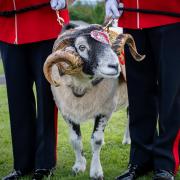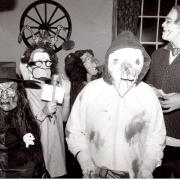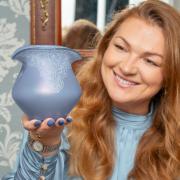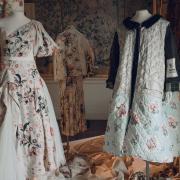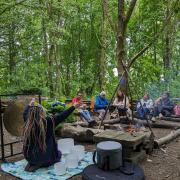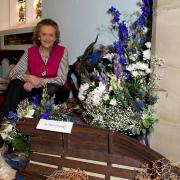Every year on May 29 (unless that date falls on a Sunday, when the custom is transferred to the neighbouring Saturday or Monday), one of Britain’s most mysterious, complex and ancient rituals is enacted in Castleton – the Garland ceremony.
The date was once widely celebrated across the land, being marked as a public holiday until 1859 under the name Oak Apple Day or Royal Oak Day.
This observance marked the Restoration of the Monarchy in 1660, when Charles II took the throne (on his birthday) following an austere 11-year period of Puritan-leaning republican government, during which the majority of public festivals were suppressed.

The association with the oak tree stems from the future king famously hiding in an oak in Boscobel Wood in 1651 to evade Roundhead troops.
Castleton’s Garland incorporates some of these elements, featuring a ‘King’ who rides around the village on horseback wearing 17th century style costume, and attendees are strongly encouraged to wear sprigs of oak leaves.
However, Janet and Colin Bord in their Atlas of Magical Britain suggest, ‘Celebrations to commemorate the… Restoration of the Monarchy after the Civil War have got mixed up with rituals originating much further back in time’.
It has been speculated the Garland could have ancient Pagan origins; an unsuspecting visitor to Castleton on May 29 would likely be astonished at the scenes unfolding and perhaps assume they had stumbled upon filming of a remake of The Wicker Man.
The most striking aspect is the Garland itself, comprising a bell-shaped structure covered with fresh flowers, constructed on the afternoon of the event and later placed over the King, who then rides around the village boundaries, visiting each pub for refreshment (each year they take it in turn to be the ‘host’ pub from where the ceremony begins).
At the end of the perambulation, the Garland is removed from the King’s shoulders and hoisted up to the roof of the church tower, where it is left to wither on the pinnacles.
Staging it is not without its challenges – caused in no small part by Castleton’s transformation from working village to honeypot tourist destination.
One local explained to me in 2015 the impact this had on mounting the custom:
‘The whole thing is under threat and children from Hope and other villages are now invited to take part [in the dancing during the procession]. This is because there are almost no children in the village, as every house that comes up for sale becomes a holiday cottage and local youngsters can't compete with the prices paid, often by non-residents (my own daughter is a case in point – they live in a substantial house in Sheffield, the price of which couldn’t buy anything in the Hope Valley).

‘The school which had around 50 children in it in the 1960s now has 16 and one of those is from Edale. We have closed our church toddlers’ group as we were down to two toddlers! Soon it will be a theme park!’
This is all rather ironic given the Garland, with its veneration of recently-sprouted foliage and fauna, seems to have a strong fertility aspect to it; locally Garland Day was informally known as ‘Baby Night’ because of the amount of conceptions that happened on the evening of the event...
May has a reputation as a lusty time of the year, but there were formerly practical reasons for these associations.
May was an encouraged time to try to produce a child, given nine months later would be February - the most slack time in the agricultural year and hence the best time to be preoccupied with giving birth and looking after a newborn.
The late Keith How grew up in Castleton, later moving to Bakewell where he ran the Bakewell Bookshop before retiring and becoming a prolific artist, creating works deeply rooted in the Peak District. Keith observed he was a textbook example of this particular aspect of Garland Day, his birthday falling February 2.
Given the paucity of local schoolchildren, recently participation in the procession and maypole dancing has widened to include children from primary schools in neighbouring Hope Valley villages.
Participants’ gender is another aspect which has been fluid over the years; before local schoolgirls became involved in the early 20th century, the dancing was performed by adult male Morris dancers.
Accompanying the Garland King on horseback is the Consort. Since 1956 this role has been performed by a woman, when Jean Abbott took on the mantle – previously, this part was taken by a man in women’s clothing and veil, the last male to perform the role being Tommy Liversidge.
Another practicality is that the Garland King ride around the village on a shire horse. With the decline in working farms in the village over the years, more recently horses have had to be imported from as far afield as Sheffield, Darley Dale and Skegness.
Arriving into Castleton on Garland Day just before 6pm, there is the palpable sense of an impending event in the air.
People are gathered on either side of How Lane by the small bus station. Two ladies have oak leaves woven into their hair; I take them to be villagers at first, but then hear them conversing in Spanish.
A dad helps his young daughter collect flowers growing wild in the verges to make a posy to place in her hair. Members of the Garland Committee carrying boughs of oak leaves are roaming the streets, handing out copies of a 1972 pamphlet about the tradition, produced for the University of Sheffield’s Survey of Language and Folklore.
They are very persuasive in a friendly way and target anyone not wearing an oak leaf. ‘Does it ward off evil sprits?’ asks one elderly gentleman after he’s pressganged into taking some in exchange for a donation to the Garland Committee.
‘No, it brings you fertility – too late for a refund now, you’ve bought it anyway’ replies the seller.

The punishment for not displaying an oak leaf is supposed to consist of receiving a ‘nettling’, i.e. being attacked with stinging nettles, but fellow folklorist John Roper, who has attended the Garland since the 1970s, told me he never witnessed this actually happening.
When I asked Garland Committee member Brian Woodall about it, he said he had previously carried nettles to maintain this part of the tradition, but had never gone so far as to deploy them on anyone, and had only ever succeeded in accidentally nettling himself.
By the time the ceremony is due to begin the majority of the crowd have oak leaves affixed somewhere about their person, the effect being quite extraordinary: it’s as though the greenery of the Garland King has spread rapidly to everyone in the surrounding area.
After the Garland has been carried through the streets and placed onto the King’s shoulders, he and his Consort ride around the village, accompanied by the Castleton Brass Band, who play the total earworm that is The Garland Tune.
A very similar tune, the Furry Dance, is played at Helston’s Flora Day in Cornwall, another May custom involving flora and greenery, leading to speculation by folklorists that Castleton’s Garland could be an imported custom brought by Cornish tin miners who relocated to the Peak District to work in the once-thriving local lead mining industry.
Castleton is well known for its caverns, and an interesting spin-off ceremony has developed amongst the local caving community, as Samuel Snowdon of Sheffield University Speleological Society informed me.
Samuel wasn't sure of the exact date the tradition began, but thought it first occurred in the 1950s, when some of the garlands from the ceremony were dropped into a waterfall located within the Giant's Hole Cave – leading to this part of the cave network acquiring the name 'Garland's Pot'.

Snowdon and some of his student caving colleagues were hoping to revive the tradition after the 2016 Garland ceremony, but unfortunately the timing of it clashed with the university’s exam period.
Elsewhere in Derbyshire, elements of Oak Apple Day were formerly practiced: schoolchildren in South Darley, Birchover and Winster were liable to be ‘nettled’ if not sporting an oak leaf into the first half of the 20th century.
At Chapel-en-le-Frith, the parish church was once decorated with greenery as at Castleton. Writing to the Derbyshire Courier in June 1838, ‘A Correspondent’ bemoaned the fact ‘Tuesday last, the 29th, being the anniversary of the happy restoration, the bells in the tower of the parish church of Chapel-en-le-Frith, for the first time probably since being placed there, were silent on the occasion. Neither were the pinnacles of the tower, as heretofore, encircled with oak branches in commemoration of events connected with that day’.
This letter from ‘A Correspondent’ demonstrates that our wonderful annual traditions only exist as long as there are people willing to organise and participate in them – so hats off to Castleton’s Garland Committee.
This article has touched on some of the changes and challenges which have been a factor in the staging of the Castleton Garland over time; let us hope the event continues to thrive and evolve, providing us with a fascinating link back to many previous generations of Derbyshire folk.




